the Zeiss Sonnar 85mm f/2.8 tested on an APS-C 24MP sensor
at close-portrait distance and at (almost) infinity
at close-portrait distance and at (almost) infinity
NOTICE: I'm writing in English because I'd like to share my lens
tests with a wide audience, yet I'm not an English speaker,
so I ask for your forgiveness if some phrases in this text
are incorrect or sound odd.
Following a number of non-scientific, poor man tests with some other legacy glasses, here I took another round of non-scientific tests to give a look at a potential champion, the (drums drums)... Carl Zeiss Sonnar T* 85mm f/2.8!!!
Indeed... I've already tested it here, but now under scrutiny is another copy of the lens that I recently bought for myself, after the very good impression the other one (that belongs to a friend of mine) left in me.
Why with the Fujifilm XT-20, a quick word about APS-C... and some opinions
Presently (January 2019), I use two APS-C digital cameras: a Pentax K50 (reflex aka DSLR, 16MP) and a Fujifilm XT-20 (mirrorrless, 24MP).
When the first X-trans sensors were out, I was very intrigued, and now that I own this XT-20 I can say that is an excellent companion for testing legacy lenses, though for shooting I often prefer the Pentax reflex, mostly because I find it more intuitive and the handling is generally better.
For testing manual focus lenses, assistance from the camera is important at wide apertures, and though I don't find the Fuji manual-focus assist ideal, it is the best I've tried up to now and I don't know if I could think of a better way to make one.
But even though a recent model, the XT-20 is already outdated regarding the Electronic Viefinder: the EVFs are improving year after year and looking into a piece of the newest breed feels like you're with a classic 35mm reflex, to the point that focus assist functions may become less relevant in the near future.
One note about APS-C sensors is due here, because sometimes I'm pointed to the fact that legacy lenses for 35mm cameras should be tested against full-frame sensors (sensors large as the 35mm films were, this is obvious for most readers but not for digital-born photographers), but I disagree.
I mean, I see the point in the objection, and I understand that a complete evaluation of the lens in itself should imply a full-frame coverage because the product was intended for it, but it is not the point for someone like me who, for some time to come, has no intention to leave the APS-C sensors for the larger full-frame.
Actually, I find that the APS-C cameras provide the right balance between compactness and quality for my purposes.
A lens with very bad corners on a full-frame may turn out a decent performer when used in conjunction with an APS-C sensor, and a lens that had as a stong point corner excellence with a small sacrifice in the center may lose its specific advantage on APS-C. In my limited experience, anyway, you can tell what to expect on a full-frame by the trend with APS-C area corners: if they are bad or just acceptable, expect a worse performance on the whole 24x36mm area (of the full-frame). Unless you are dealing with some specific optic arrangements.
Back to the XT-20, I'm repeating myself here (see some other tests of mine), but it's worth to stress that:
- the sensor is fantastic, and 24 megapixels are probably enough to benchmark most legacy lenses. 16MP may be insufficient
- in-camera JPEG processing is unmatched. Really, compare to any camera of any other brand and you'll see! At least as of mid-2018. It saves a lot of time with tests
- (not relevant here) it's small. Sometimes a damnation, sometimes a blessing. With a pancake lens can fit in a pocket
- (not relevant here) mechanical quality of the body seems excellent. Time will tell
- (not relevant here) looks gorgeously old-style
- some controls are just like where they should be, including shutter speed, but in general I find the camera a bit confusing/non-intuitive, maybe I just have to get used to it, anyway sometimes I do the wrong thing and I have to restart a test batch
- it has plenty of features, some very useful for my purpose here though common to most mirrorless cameras (focus-assist, EVF luminosity reflecting the actual exposure, etc.)
- (not relevant here) mechanically speaking, Fujinon products are superb, especially the lenses
Sonnar 85mm variants
The Sonnar scheme has been replicated by many manufacturers for their lenses, though in the beginning no vendor could match the T* coating from Zeiss; also he quality control of the German company was very strict.
That said, also the Zeiss for the Contax have some variants and namely they are the AE and MM, the former being the older (my version, I think). As for which one is better, there is non consensus, anyway the optical scheme is the same. They differ in the aperture blades and possibly in the coating.
You can find some infornation here and and here, or just search the web, there is quite a lot on the topic (on the Zeiss site you can also download the original spec sheet with the MTF charts).
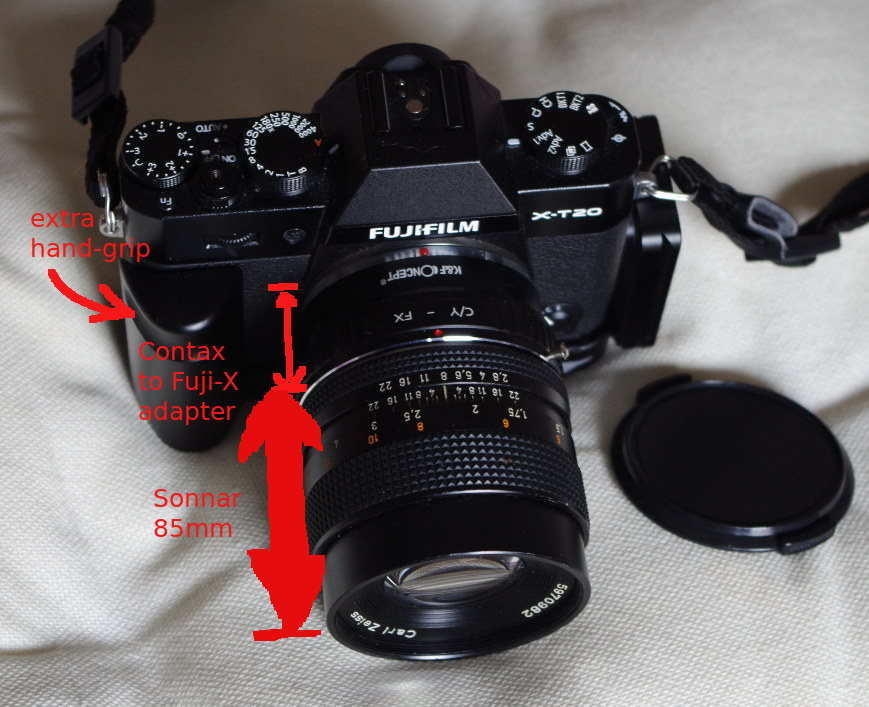
The Sonnar attached to XT-20. Notice how comfortably short the lens is.
Adapters are very common and there are many brands producing them, the one here is rather cheap but is fine.
The quick review of the Carl Zeiss Sonnar T* 85mm f/2.8 at portrait distance
First of all, I like a lens, even if intended for portraits, to be as sharp as possible. Some say they don't care for sharpness in portraits, I do. With some editing, you can smooth an image and lose some details, but you can't create them.
The same applies, for my taste, also for corners. What if I want sharp eyebrows and I want to place the subject on the left or right side of the frame? I like lenses to be sharp, it is how I like it.
The Carl Zeiss T* Sonnar 85mm f/2.8 (specifically with the Contax-Yashica bajonet, in my case) is a lens which has been highly praised for a long time.
I'm not inclined to believe everything that is found on the Internet (or word that has been passed down from generation to generation of photographers), yet I was looking for a lens of this kind, actually hoping for something with a bit wider aperture (f/2, for use in theaters, during rehearsal), but when the price was right I couldn't resist and gave it a try.
My skepticism also comes from a little experience with the renowned 50mm Planar cousins that was far from satisfactory though the another copy of the same Sonnar 85mm product did quite well (see here), though I understand that we're speaking of aged lenses that may also have udergone some maintenance, so you cannot judge a whole line by one or two samples, even when confronted with the legendary mechanical quality of the Zeiss items.
Well, I must say this time I've been positively surprised, even beyond my expectations (the last time I was more fretful and only tested the lens for the short distance). I must clarify that I am looking for a very good lens that I can use at f/2.8, because I found that such aperture is useful for taking shots in low light (theaters, mainly during rehearsal) with the Fujifilm XT-20: at ISO 1600 and f/2.8 one can manage to use a 1/90th of a second most of the times, barely enough to freeze the action and to contain the noise.
I don't know if I actually will be able to work with a non-autofocus lens, but the temptations for old glasses is so strong! I was aiming at an f/2 (or better) because usually at full aperture lenses are bad, but one stop down is sufficient to obtain good results from good lenses. This is just a very silly rule of thumb, but it works!
Well, with the Sonnar 85mm at portrait distance you don't need to stop down, at f/2.8 it is definitely a great lens and not just in the centre but down to the corners! The performance at full aperture is where it exceeded my expectations.
Instead of providing the usual bunch of images, I think that the few crops collected here will be sufficient to make my point. All the pictures have been taken at 400 ISO, for each aperture I have tried twice, refocusing, then I picked the best center and the best corner crop, both from the same shot, this is important if you want to make sure that the center and the corners share the same focus plane (even though with non-wideangles such an issue should not appear).
Here they are:
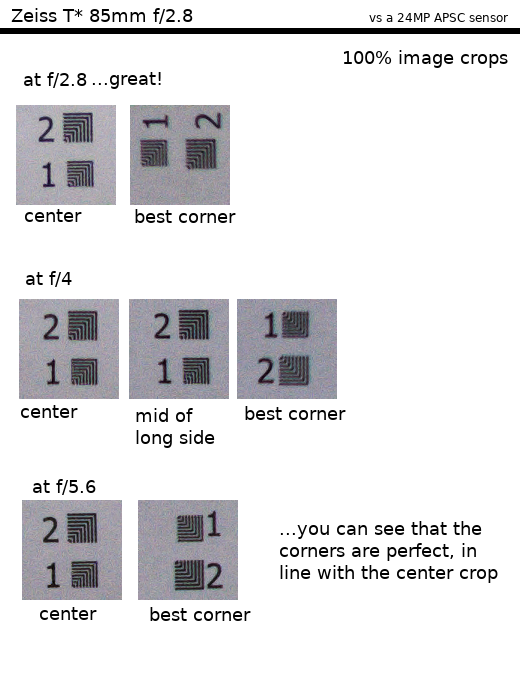
A small amount of vignetting is evident at f/2.8 (one "stop", maybe?) but I'd say it's not disturbing, it becomes even less relevant at f/4 and it's gone at f/5.6.
The same can be said of corner sharpness, the blur is minimal and as for lateral chromatic aberration, well, I think that the ridicoulous if not invisible green fringing in the f/2.8 crop is nothing to tell home about.
From the point of view of the construction, this is a very compact (very, for an 85mm!), well-built piece of mechanics. The focus ring is very fluid and precise. Did you expect anything else from a Zeiss?
The Carl Zeiss Sonnar T* 85mm f/2.8 at long-distance focus
The climate hasn't been good in Rome this two weeks, and whenever I had time to reach my favourite point of view for long distance testing, it was cloudy or hazy. So I capitulated and shot without the precious sun rays that could provide a lot more contrast in the scene.
Nevertheless, the crops I am presenting here clearly mark another victory for this splendid glass: again, the lens is very good since f/2.8, maybe slightly worse than for the shorter distance tests, but there's really nothing to complain about.
I've picked little frames where very thin lines can be spotted, especially railings outside balconies, and you can see for yourself the outcome.
The JPEG files produced by the camera are practically noise-free, while a straight elaboration of the RAW images with RawTherapee adds some noise (yes, I know rawtherapee can do better, but controls are so many...) and sometimes, not always, can highlight a few more details. I added some from both (in-camera jpeg and reawtherapee-elaborated crops) to squash your curiosity.
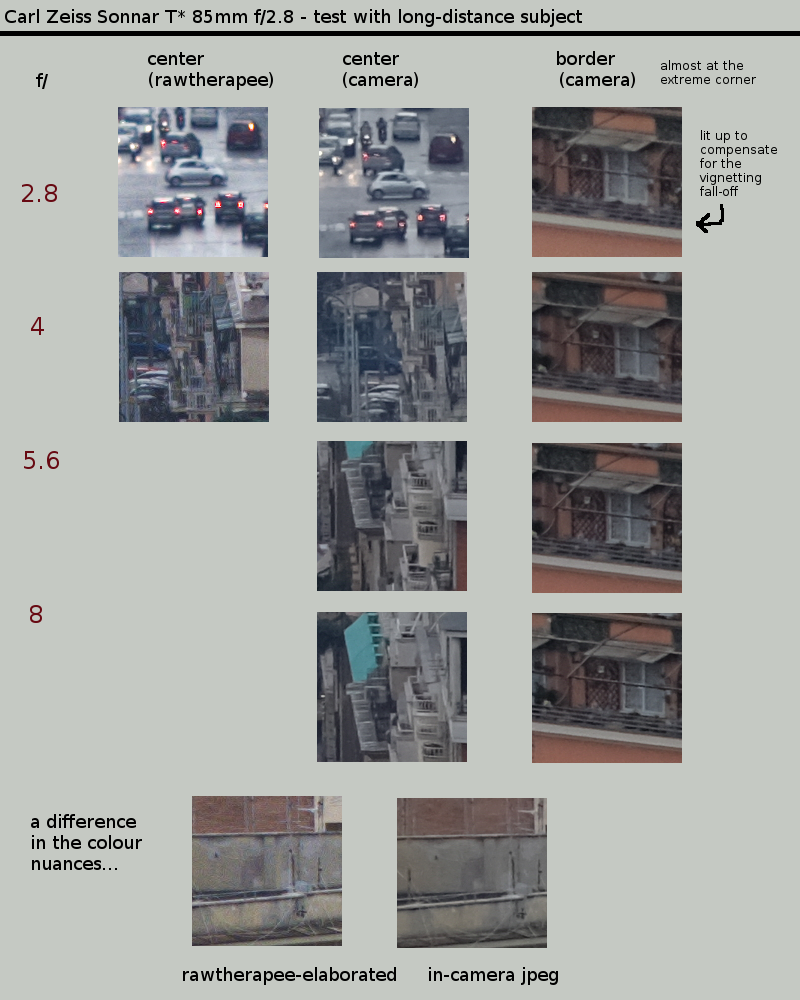
Bokeh
Well, this is a matter of taste, but the bokeh (quality of the image in out-of-focus areas) is something that photographers try to judge, especially when the lens is a candidate for portrait shooting.
I think that the bokeh here is pleasantly creamy, with occasional nervousness, generally very good but maybe not exceptional.
The two following photos are taken at full aperture (f/2.8) and can tell more than my words:
Conclusion
It's a pity that I'm sharing such few phrases and praises for this beautiful legacy glass, but in absence of defects there is not much to say... you see, this copy of the Zeiss Sonnar 85mm is definitely satisfactory if not exceptional.
Sharpness is very good since the full aperture, even at corners, gets excellent once stopped down, the performance is consistent with short and long-distance subjects; aberrations are negligible, sphericity-bound issues did not come out.
Alas, I've not tested for flare-resistance.
Mechanically speaking there is nothing to complain about, someone shoud write a poem on it.
Also, the body of this product is very compact -some 50mm lenses are just a bit shorter and some are even much longer!
I'll keep the lens even if won't use it, that's enough to say.
Maybe I'll buy another very tempting piece, which is (for its compactness, given that the relative adapter is very short) the Zeiss Sonnar 90mm f/2.8 with Contax G bajonet, possibly a bit better than the 85mm (the 90mm came out much later, indeed). Provided that I want to struggle with the Contax G adapters!... but even so, I don't plan to sell the 85mm, and that's all!
A couple of shots
Here come a few photos taken a few days after the test at glass artisan shop, they don't represent a "selection" but can certainly tell something. They are not 1:1 crops, and a little sharpening has been applied.
For your information, the shop is located in Anguillara, a small city near Rome and is run by Anne, you can look for her on Facebook ("Anne Gioielli in vetro") or you can just click here
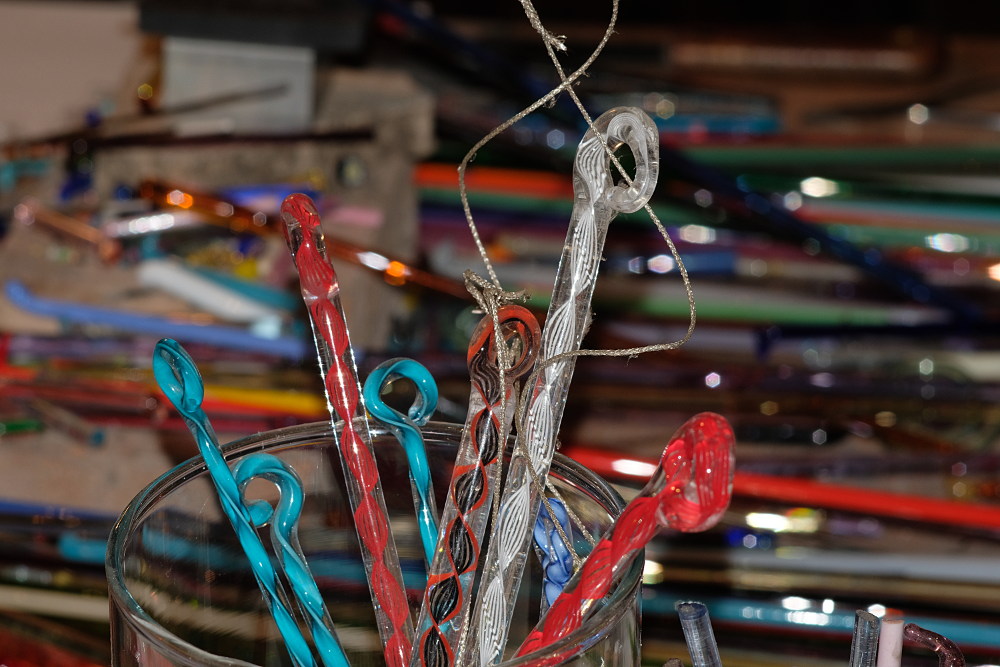
The artisan's glass shop was dimly lit, yet it was possible to focus properly and the good aperture helped.
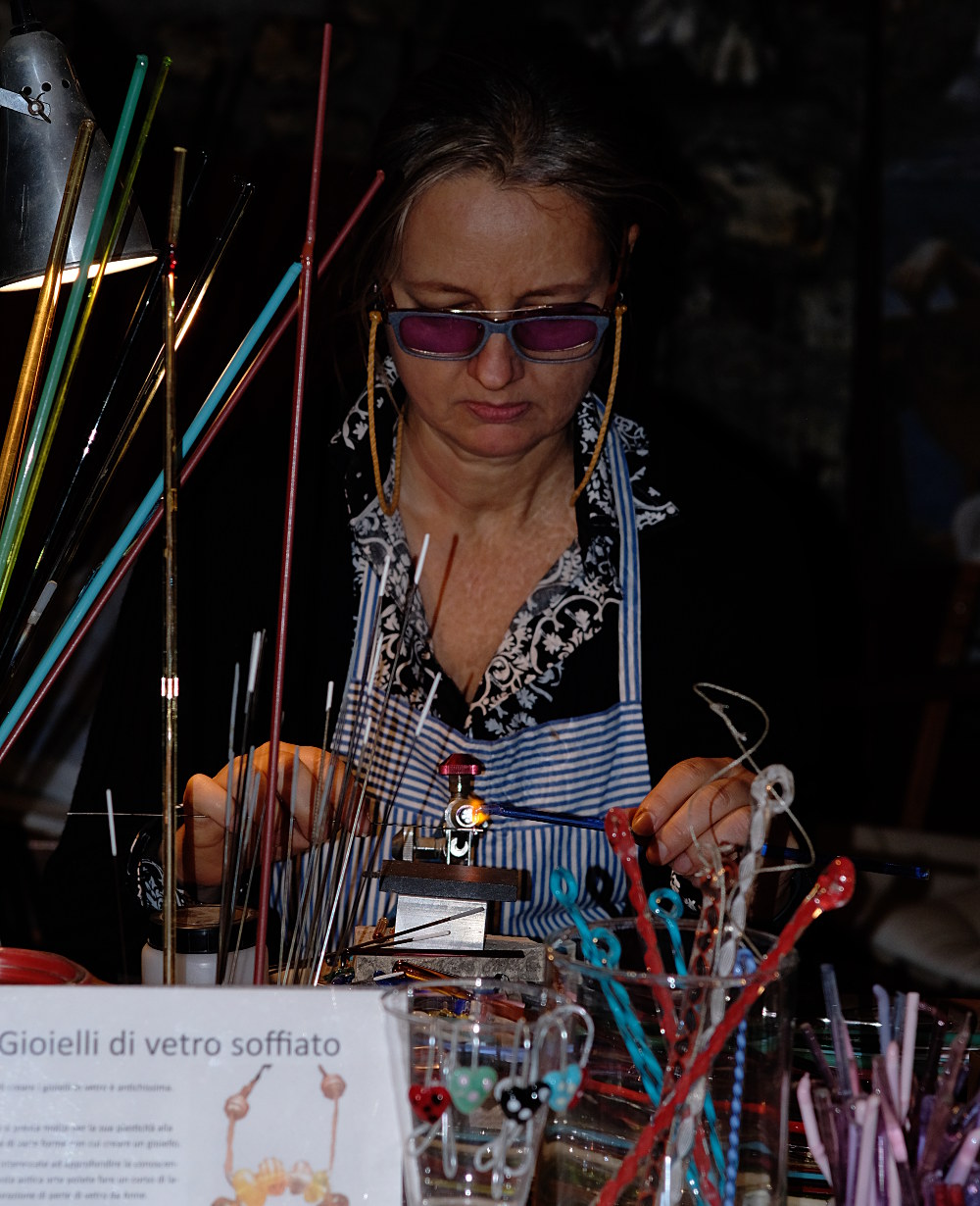
Outside the shop this big bottle was standing, with some glass sticks inside.
Notice the beautiful transparent brown of the container and the thin filaments on the right (a spider web).
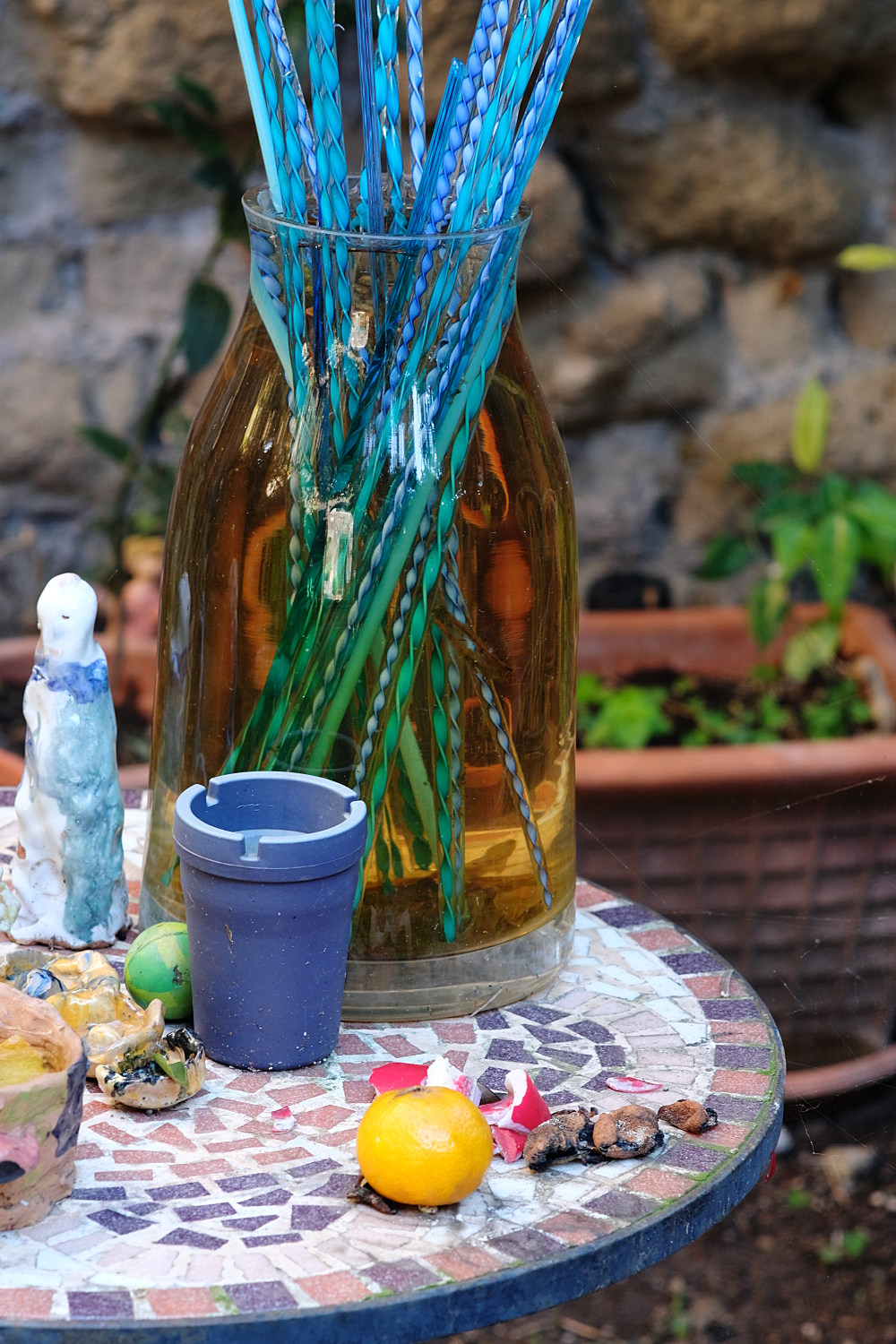
I wish that you, dear photo-friend, will find these tests useful. Long live photography!
| Back to the site index | ||
| Do you love Italy? Check my little site, I hope to find the time to make it grow! | ||